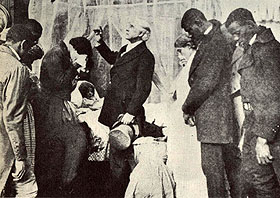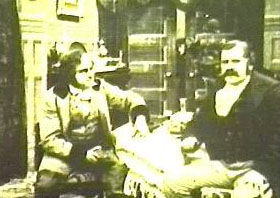release, containing a scene that was cut
from the 1927 re-release.

CLICK TO ENLARGE

TO FILM IN 6-REEL VERSION
The 3-reel format follows the basic organization of the novel into three parts: Kentucky, New Orleans and Legree's plantation. George Harris does not appear and the northern movement toward freedom in Canada is almost entirely omitted; it ends with Eliza crossing the ice, shown in reel 1.
Only one print of the 1910 Vitagraph version seems to have survived: designed for European distribution, its titles are in Danish, and it is in The National Film and Television Archive, in London. The version available in the archive through the link at left is digitized from a re-release of the film by another company (the Empire Safety Film Company) in the late 1920s, around the time of Universal's big budget Uncle Tom. This version, according to Brewster and Jacobs*, was intended for home use, and divides the film into six reels. At about 20 minutes in length, the re-release is about half as long as the original. But the clips here will give you a good idea of the way the story looked to film audiences in 1910.
